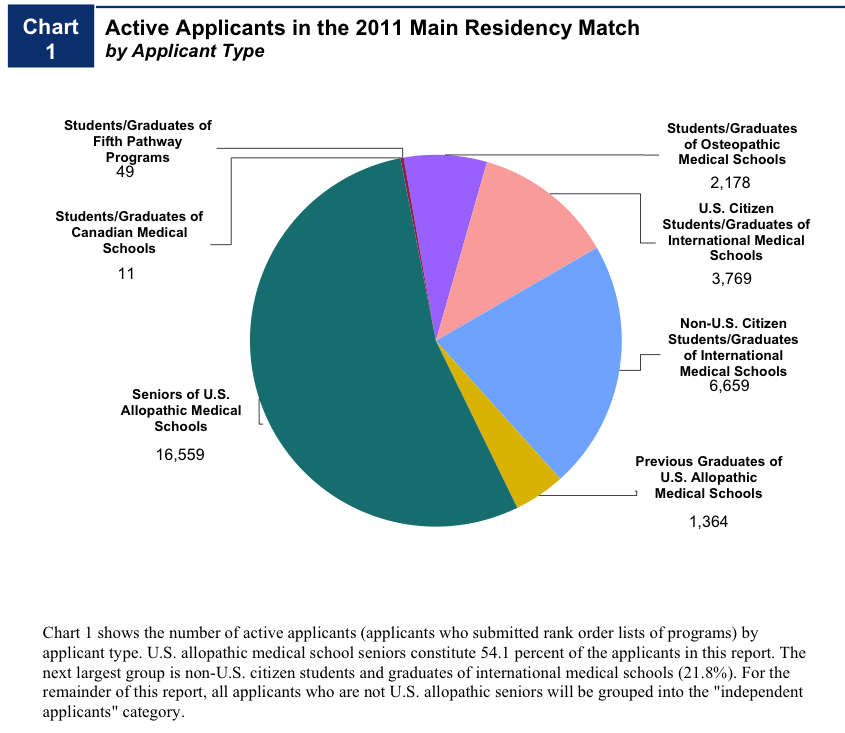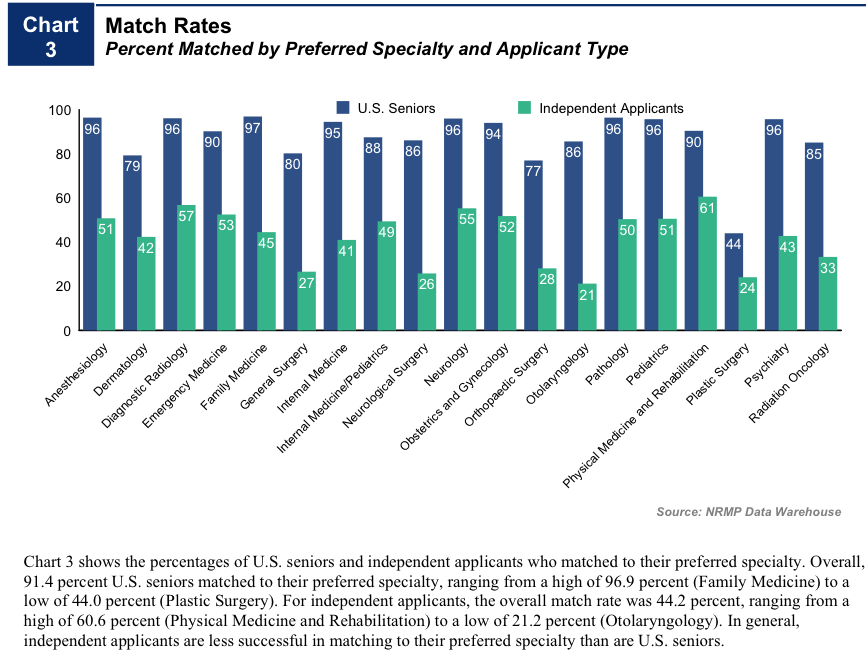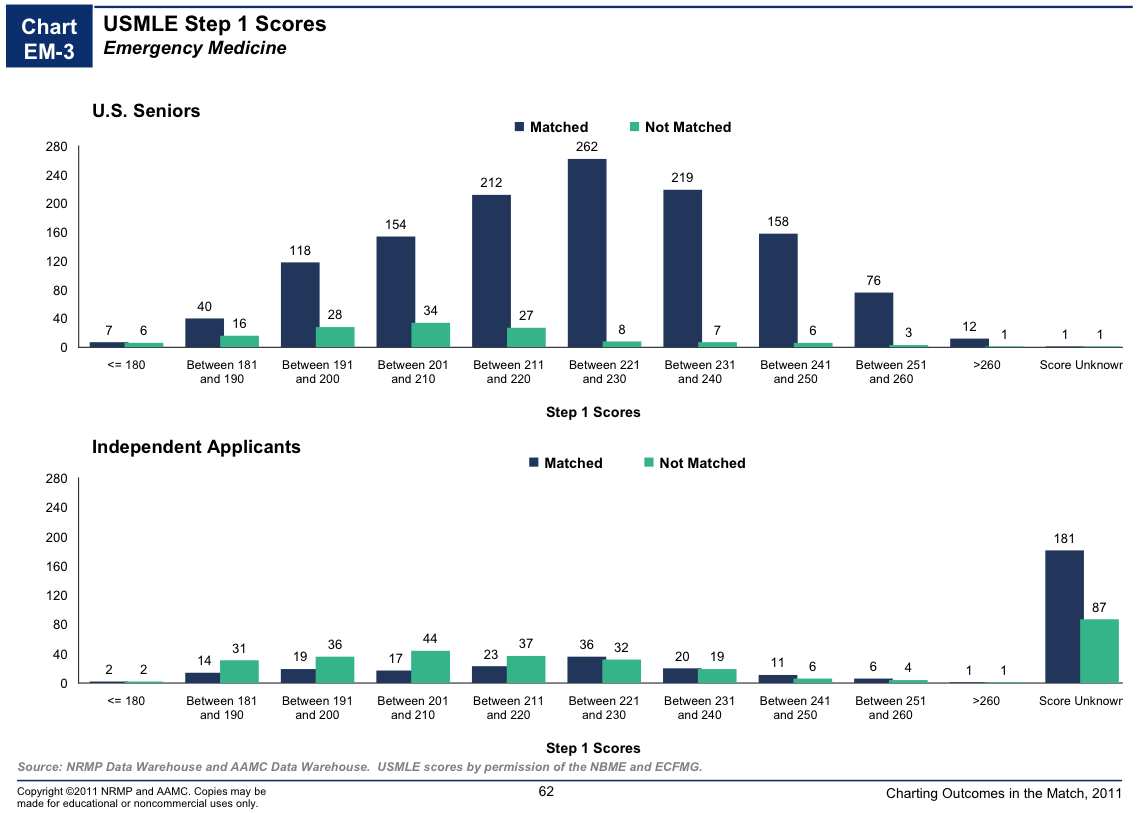I have been hearing a lot of gloom and doom about the upcoming residency crunch. Is it really possible that DOs will be forced out of ACGME programs by 2016 ? If this happens what percentage of DO graduates will be able to match into a residency ?
You are using an out of date browser. It may not display this or other websites correctly.
You should upgrade or use an alternative browser.
You should upgrade or use an alternative browser.
GME for the class of 2016
- Thread starter GVL3020
- Start date
I have been hearing a lot of gloom and doom about the upcoming residency crunch. Is it really possible that DOs will be forced out of ACGME programs by 2016 ? If this happens what percentage of DO graduates will be able to match into a residency ?
I don't think DOs will ever be forced out of the ACGME, but, yeah, I think the class of 2016 is going to have some trouble. There were 3845 DO graduates in 2010. 4623 in 2012, and I think the class of 2013 is going to have around 5100. So, I'd imagine, the class of 2016 is going to have +6k graduates.
AOA residencies haven't been growing as fast. In 2007, there were 2189 post graduate spots and in 2012 there 2655 AOA post graduate programs. These numbers include 1-year interships too, so the actual number of residency spots is even lower.
I think all future applicants should be content with primary care before applying. Plenty will continue to specialize, but more will enter primary care than recent years.
Last edited:
- Joined
- Mar 8, 2011
- Messages
- 1,673
- Reaction score
- 26
Anyone know the trends with the NRMP match? Are MD residencies accepting more DO's or less DO's?
Last edited:
- Joined
- Aug 28, 2009
- Messages
- 1,680
- Reaction score
- 12
They're accepting more. The DO match rate has been relatively going up, little by little. The current match rate is 72% in the NRMP match. The NRMP match typically grows by about 500 spots a year over the past couple of years.Anyone know the trends with the NRME match? Are MD residencies accepting more DO's or less DO's?
- Joined
- Aug 7, 2005
- Messages
- 4,948
- Reaction score
- 1,116
The crunch won't really affect DOs in the MD residencies a huge amount I don't think. The crunch will first be felt on IMGs. When we start seeing almost no IMGs at all in the acgme matching, DOs should start worrying. And there are many unfilled spots for both. Instead of focusing on adding more, I think they need to make the MD and DO spots more desirable.
- Joined
- Jun 1, 2009
- Messages
- 1,210
- Reaction score
- 21
As a US MD/DO class of 2016, you'll have little trouble landing a residency in the states. However since the number of grads is increasing at higher pace than residency spots, there will be more competition for desirable residencies or residencies in high end locations such that board scores among other things will get even more important.
- Joined
- Aug 12, 2010
- Messages
- 2,811
- Reaction score
- 1,138
As a US MD/DO class of 2016, you'll have little trouble landing a residency in the states. However since the number of grads is increasing at higher pace than residency spots, there will be more competition for desirable residencies or residencies in high end locations such that board scores among other things will get even more important.
Work hard and the doom&gloom won't be your problem.
- Joined
- Nov 19, 2009
- Messages
- 1,001
- Reaction score
- 151
This thread has made me feel tremendously better about my future. 
- Joined
- Mar 8, 2011
- Messages
- 1,673
- Reaction score
- 26
Let's look at the numbers. Here's the NRMP match (aka MD match). US allo seniors make up over half of the applicants (54.1%). The rest of the chart groups osteo, IMG, and non-US IMG graduates together, collectively called "Independent applicants".
(download the 2011 Charting Outcomes in the Match PDF here)

Notice the number of successful independent matches. It's unfortunate they lumped IMG's and DO's into the same category, I would love to see the difference.

Let's take a perennial SDN favorite: Emergency Medicine. Notice the difference in Step 1 scores between US Seniors and Independents. Again, IMG's are lumped in with DO's, which is unfortunate, as IMG's usually have about 6-8 months of straight studying whereas MD and DO students usually only have 6 weeks.

For an 80% probability of matching into an MD EM residency as a US allopathic senior, you only need a Step 1 score of ~195. For the same chance, DO/IMG students need a Step 1 of almost 260!

This does not take into consideration the whole application portion of getting interviews and audition rotations. Of course there are old skool Program Directors who think negatively about DO students and throw all their apps in the trash, but I believe this is not as common as once thought. But for a mildly competitive EM residency, they get thousands of apps for only a few spots, and they can be very selective when setting their criteria. Just goes to show that doing well on Step 1 is the absolute most important component in order to open up residency opportunities in all fields (except for FM, PM&R, and Psych).
(download the 2011 Charting Outcomes in the Match PDF here)

Notice the number of successful independent matches. It's unfortunate they lumped IMG's and DO's into the same category, I would love to see the difference.

Let's take a perennial SDN favorite: Emergency Medicine. Notice the difference in Step 1 scores between US Seniors and Independents. Again, IMG's are lumped in with DO's, which is unfortunate, as IMG's usually have about 6-8 months of straight studying whereas MD and DO students usually only have 6 weeks.

For an 80% probability of matching into an MD EM residency as a US allopathic senior, you only need a Step 1 score of ~195. For the same chance, DO/IMG students need a Step 1 of almost 260!

This does not take into consideration the whole application portion of getting interviews and audition rotations. Of course there are old skool Program Directors who think negatively about DO students and throw all their apps in the trash, but I believe this is not as common as once thought. But for a mildly competitive EM residency, they get thousands of apps for only a few spots, and they can be very selective when setting their criteria. Just goes to show that doing well on Step 1 is the absolute most important component in order to open up residency opportunities in all fields (except for FM, PM&R, and Psych).
- Joined
- Jun 1, 2009
- Messages
- 1,210
- Reaction score
- 21
I know that chart and I don't wouldn't put much stock in it unless I were future carib or Foreign graduate (IMG). there are wayyyy more IMG's applying for ACGME residency spots than DOs. DOs are far fewer in number and even then about 50-60% of them apply ACGME. You're right a good Step 1 score is a must, but to extrapolate from the graph that a DO/IMG needs a 260 step score for a 80% chance of matching EM is deceptive since the sheer number of IMGs shrouds the true step1 score a DO needs to match. the real number is muuchh closer to 195 than it is 260 for a DO in the example you mentioned.
6659 (foreign born IMG)+3769 (US citizen IMG)= 10,428 total MD gradutes from non-US medical schools
2718 (US DO)
This means there were almost 4 times the number of IMGs applying ACGME than DOs in 2011 and in the chart above.
6659 (foreign born IMG)+3769 (US citizen IMG)= 10,428 total MD gradutes from non-US medical schools
2718 (US DO)
This means there were almost 4 times the number of IMGs applying ACGME than DOs in 2011 and in the chart above.
Last edited:
- Joined
- Aug 28, 2009
- Messages
- 1,680
- Reaction score
- 12
Like Donkey said, you cannot follow that graph for DO applicants. They're far outnumbered by IMG and FMG applicants. Besides, for EM, most DO's just do DO EM residencies, and they're automatically pulled out of the NRMP match, once they match into the DO match.
- Joined
- Sep 23, 2007
- Messages
- 597
- Reaction score
- 5
Let's look at the numbers. Here's the NRMP match (aka MD match). US allo seniors make up over half of the applicants (54.1%). The rest of the chart groups osteo, IMG, and non-US IMG graduates together, collectively called "Independent applicants".
Notice the number of successful independent matches. It's unfortunate they lumped IMG's and DO's into the same category, I would love to see the difference.
Let's take a perennial SDN favorite: Emergency Medicine. Notice the difference in Step 1 scores between US Seniors and Independents. Again, IMG's are lumped in with DO's, which is unfortunate, as IMG's usually have about 6-8 months of straight studying whereas MD and DO students usually only have 6 weeks.
For an 80% probability of matching into an MD EM residency as a US allopathic senior, you only need a Step 1 score of ~195. For the same chance, DO/IMG students need a Step 1 of almost 260!
This does not take into consideration the whole application portion of getting interviews and audition rotations. Of course there are old skool Program Directors who think negatively about DO students and throw all their apps in the trash, but I believe this is not as common as once thought. But for a mildly competitive EM residency, they get thousands of apps for only a few spots, and they can be very selective when setting their criteria. Just goes to show that doing well on Step 1 is the absolute most important component in order to open up residency opportunities in all fields (except for FM, PM&R, and Psych).
DOs comprise 5-7% of the NRMP applicants (not counting the ones that matched into AOA first and did not submit ROLs as they were dropped by NRMP and therefore were not included in those graphs).
IMGs comprise about 40-45% of the NRMP applicants.
Therefore, those graphs are TOTALLY useless for DOs since they lump DO and IMG and you definitely do NOT need a 260 (or anything remotely close to that) to match EM as a DO.
Edit: Apparently not necessary
Is there any charting outcome data for just DO applicants in the NRMP match? I would be curious to see it.
NO!
Last edited:
I'm pretty sure that the charting outcome data about independent applicant board scores does not include DO applicants. In the document it says, "Almost all of the applicants who did not have Step 1 scores were osteopathic medical school seniors and graduates who either take an alternative examination (the Comprehensive Osteopathic Medical Licensing Examination, or COMLEX-USA) or who take the USMLE exams but whose data are not shared with the AAMC." And if you look at the number of DO applicants that matched a particular ACGME speciality and you compare that number to the number of unknown scores, they usually are the same or similar. So, for example, if you look at the EM info posted above, there were 181 people that matched EM with unknown boards scores and in 2011 there were 177 DOs that matched PGY1 EM and 4 that matched PGY2 EM.
- Joined
- Nov 21, 2006
- Messages
- 307
- Reaction score
- 37
Your posts are USUALLY decent but you have been slipping recently (esp. today)... You have to re-start utilizing some of those critical thinking skills that I know you posses...
You have been reading too much into few OMS-IVs posts at a time when everyone is really nervous about outcomes.
Unnecessary.
- Joined
- Sep 23, 2007
- Messages
- 597
- Reaction score
- 5
I'm pretty sure that the charting outcome data about independent applicant board scores does not include DO applicants. In the document it says, "Almost all of the applicants who did not have Step 1 scores were osteopathic medical school seniors and graduates who either take an alternative examination (the Comprehensive Osteopathic Medical Licensing Examination, or COMLEX-USA) or who take the USMLE exams but whose data are not shared with the AAMC." And if you look at the number of DO applicants that matched a particular ACGME speciality and you compare that number to the number of unknown scores, they usually are the same or similar. So, for example, if you look at the EM info posted above, there were 181 people that matched EM with unknown boards scores and in 2011 there were 177 DOs that matched PGY1 EM and 4 that matched PGY2 EM.
^^This post should be a sticky for at least the next 10 years...
Good catch
Either way, those graphs can not be utilized as a reliable tool/predictor for DOs....
Unnecessary.
Maybe so; but it wasn't intended as too harsh of a criticism.... As I said s/he USUALLY has decent posts...
And I'll take it out of my post if it'll make you feel better!
Last edited:
- Joined
- Jun 1, 2009
- Messages
- 1,210
- Reaction score
- 21
I'm pretty sure that the charting outcome data about independent applicant board scores does not include DO applicants. In the document it says, "Almost all of the applicants who did not have Step 1 scores were osteopathic medical school seniors and graduates who either take an alternative examination (the Comprehensive Osteopathic Medical Licensing Examination, or COMLEX-USA) or who take the USMLE exams but whose data are not shared with the AAMC." And if you look at the number of DO applicants that matched a particular ACGME speciality and you compare that number to the number of unknown scores, they usually are the same or similar. So, for example, if you look at the EM info posted above, there were 181 people that matched EM with unknown boards scores and in 2011 there were 177 DOs that matched PGY1 EM and 4 that matched PGY2 EM.
ha ha good eye man. that does make sense since AOA and ACGME info don't usually go together.
- Joined
- Mar 8, 2011
- Messages
- 1,673
- Reaction score
- 26
Battling massive hangover today. Critical thinking skills are shot. Looking back, pink text? Really?! What was I thinking?! 
Bala, I don't know why you feel the need to attack me and nitpick every post I've made, but if it makes you feel like a real man then go for broke, son.


Bala, I don't know why you feel the need to attack me and nitpick every post I've made, but if it makes you feel like a real man then go for broke, son.
- Joined
- Sep 23, 2007
- Messages
- 597
- Reaction score
- 5
Battling massive hangover today. Critical thinking skills are shot. Looking back, pink text? Really?! What was I thinking?!
Bala, I don't know why you feel the need to attack me and nitpick every post I've made, but if it makes you feel like a real man then go for broke, son.
Dude, man, bro, I said your posts are usually good (in my universe that's a compliment).. I wasn't attacking you.... I just pointed out that you can't draw conclusions from those graphs because of the disproportionately high number of IMGs to DOs.... That is not nitpicking, it is pointing out facts, my friend (IMHO)
Last edited:
Similar threads
- Replies
- 0
- Views
- 417
